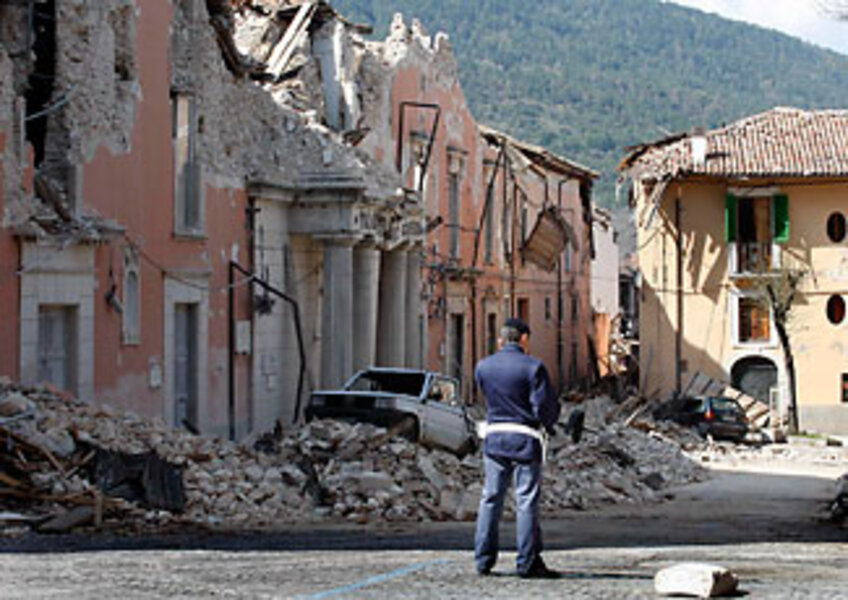After earthquake, Italians ask questions about building codes
| Milan, Italy
Four days after a devastating earthquake in central Italy left more than 280 people dead, attention is turning to whether a culture of impunity toward building codes contributed to the high number of casualties.
Many of the centuries-old buildings in L'Aquila, where the 6.3-magnitude quake struck overnight Sunday, sustained severe damage. But newer buildings were also affected. With Prime Minister Silvio Berlusconi vowing to rebuild the stricken town, some experts say, more stringent building codes are needed – along with tougher enforcement to ensure compliance.
"It know it sounds horrible to say this, but geologically speaking, it was not a big earthquake at all," says Alessandro Martelli, a professor of antiseismic engineering at the University of Ferrara. He notes that the majority of houses in Italy were built without any antiseismic precautions, although 70 percent of the country's territory is considered a seismic zone. Echoing a sentiment widely expressed in Italy, he adds, "If we were in Japan, a tremor of this magnitude probably wouldn't even have made it to the front page."
The problem is not a lack of technical expertise in building in earthquake zones. "Some of the new technologies that are now widely used in Japan and North America, were first tested here," Mr. Martelli says. But the law did not always keep pace, nor was it always applied: "Either for bureaucratic reasons or for economic concerns they were not taken into account by authorities."
On Thursday, Italy appealed for international aid to help rebuild the historic churches and monuments damaged by the country's worst earthquake in three decades. Mr. Berlusconi boosted emergency aid to €100 million ($132 million) and said that reconstruction would cost billions of euros.
Thirty tent camps have been built in l'Aquila and surrounding towns, hosting nearly 18,000 people. Some 28,000 people are thought to have lost their homes. Priority was given to sheltering children and the elderly, leaving some people to spend the night in their cars, state-owned TV Rai Tre reported.
In response to the need, many hotels and private houses in nearby provinces have opened their doors, attracting about 10,000 people. The majority of l'Aquila's inhabitants, however, have chosen to stay in the tents, according to Rai Tre. Many have been concerned about protecting their homes amid reports of some looting. For now, authorities are forbidding citizens to enter the city center; even if their houses are still standing, people are not being allowed in as structures may be unsafe and tremors are continuing, with a minor one hitting Thursday morning.
An earthquake six years ago helped shock lawmakers into moving to tighten construction codes. Italy's first modern law on antiseismic norms was passed in 1976, as a response to the temblor that devastated the Trentino Alto Adige, a northern province in the Alps. But in 2003, a law was approved in response to a quake that shook Molise, a mountain region in central Italy, not far from L'Aquila. A school collapsed, killing 27 children.
The law was "definitively a big step forward," according to Martelli: Not only is it up-to-date with modern technologies and mandatory compliance, but it also requires old buildings to be modified to meet least some antiseismic standards. But enforcement was postponed, with governments that came to power after 2003 issuing a series of extensions. The antiseismic laws will become mandatory for most buildings only in the summer of 2010, although some economic incentives are being offered for current construction.
Even in the few cases for which antiseismic laws are mandatory, they have been largely ignored. Schools and medical facilities, for example, were supposed to comply immediately, but that has not always been the case. The hospital in L'Aquila, for example, built in 1979, was completely destroyed. A report by Legambiente, an environmental group, says that 50 percent of schools are not in compliance with earthquake codes.
Following the widespread devastation among the city's buildings, local prosecutors have opened a file for "unintentional manslaughter" against unknown offenders, seeking to punish those responsible. But many observers doubt that people will be brought to trial, says Alessandro De Angelis, an investigative journalist from L'Aquila, who is currently based in Rome. "The main responsibility lies in the wave of building speculators of the 1960s and 1970s," he says, most of whom are no longer alive.
Part of the problem is rooted in the economic boom of that period that prompted a rush to build. Thousands of cheap concrete buildings were quickly constructed all across Italy, without much concern for safety. L'Aquila was no exception: much of the dormitory of the University of L'Aquila, for instance, was built in this time frame. The facility completely collapsed in the quake, costing four students their lives. (Most students had already left for Easter break.)





